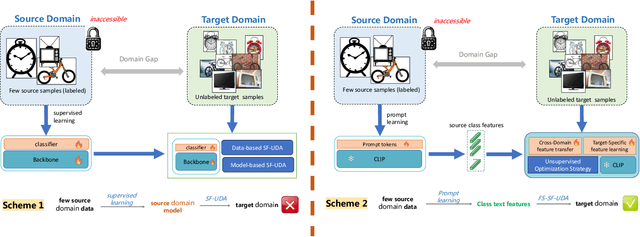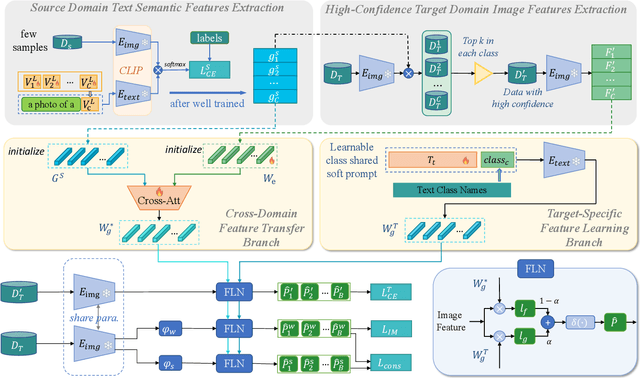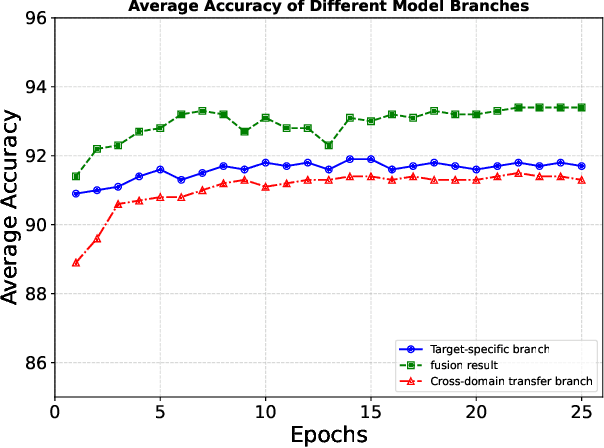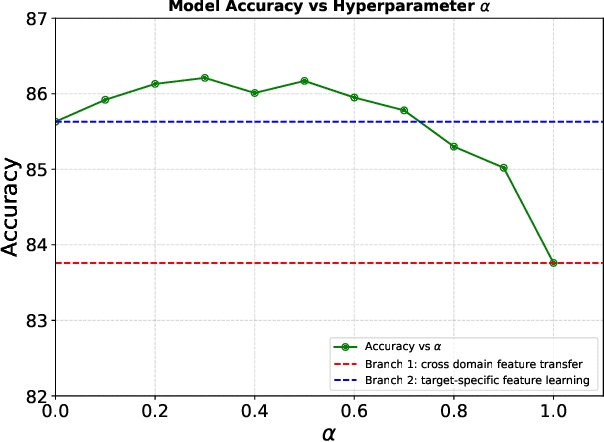Shengsheng Wang
Uncertainty-Aware Spatial Color Correlation for Low-Light Image Enhancement
Aug 06, 2025Abstract:Most existing low-light image enhancement approaches primarily focus on architectural innovations, while often overlooking the intrinsic uncertainty within feature representations particularly under extremely dark conditions where degraded gradient and noise dominance severely impair model reliability and causal reasoning. To address these issues, we propose U2CLLIE, a novel framework that integrates uncertainty-aware enhancement and spatial-color causal correlation modeling. From the perspective of entropy-based uncertainty, our framework introduces two key components: (1) An Uncertainty-Aware Dual-domain Denoise (UaD) Module, which leverages Gaussian-Guided Adaptive Frequency Domain Feature Enhancement (G2AF) to suppress frequency-domain noise and optimize entropy-driven representations. This module enhances spatial texture extraction and frequency-domain noise suppression/structure refinement, effectively mitigating gradient vanishing and noise dominance. (2) A hierarchical causality-aware framework, where a Luminance Enhancement Network (LEN) first performs coarse brightness enhancement on dark regions. Then, during the encoder-decoder phase, two asymmetric causal correlation modeling modules Neighborhood Correlation State Space (NeCo) and Adaptive Spatial-Color Calibration (AsC) collaboratively construct hierarchical causal constraints. These modules reconstruct and reinforce neighborhood structure and color consistency in the feature space. Extensive experiments demonstrate that U2CLLIE achieves state-of-the-art performance across multiple benchmark datasets, exhibiting robust performance and strong generalization across various scenes.
ANPrompt: Anti-noise Prompt Tuning for Vision-Language Models
Aug 06, 2025Abstract:Prompt tuning has emerged as an efficient and effective technique for adapting vision-language models (VLMs) with low computational overhead. However, existing methods often overlook the vulnerability of prompt-tuned VLMs to weak semantic perturbations-such as subtle image or text noise-that degrade their generalization to unseen classes. To address this limitation, we propose ANPrompt, a novel prompt tuning framework designed to enhance robustness under such perturbations. ANPrompt first constructs weak noise text features by fusing original and noise-perturbed text embeddings, which are then clustered to form noise prompts. These noise prompts are integrated with learnable prompt tokens to generate anti-noise prompts, which are injected into the deeper layers of both image and text encoders. To further capture the noise-aware visual semantics, ANPrompt computes the Noise-Resistant Visual Prompt Prototype (NRVPP) by averaging the output prompt tokens from the vision encoder. Finally, ANPrompt introduces alignment, robustness, and anti-noise objectives by computing a Weak semantic noise Alignment Loss (WALoss) alongside the standard cross-entropy and sim loss. Experiments across 11 benchmarks demonstrate that ANPrompt consistently outperforms existing prompt tuning approaches, achieving superior robustness to semantic noise and improved generalization to novel categories.
Robust Misinformation Detection by Visiting Potential Commonsense Conflict
Apr 30, 2025Abstract:The development of Internet technology has led to an increased prevalence of misinformation, causing severe negative effects across diverse domains. To mitigate this challenge, Misinformation Detection (MD), aiming to detect online misinformation automatically, emerges as a rapidly growing research topic in the community. In this paper, we propose a novel plug-and-play augmentation method for the MD task, namely Misinformation Detection with Potential Commonsense Conflict (MD-PCC). We take inspiration from the prior studies indicating that fake articles are more likely to involve commonsense conflict. Accordingly, we construct commonsense expressions for articles, serving to express potential commonsense conflicts inferred by the difference between extracted commonsense triplet and golden ones inferred by the well-established commonsense reasoning tool COMET. These expressions are then specified for each article as augmentation. Any specific MD methods can be then trained on those commonsense-augmented articles. Besides, we also collect a novel commonsense-oriented dataset named CoMis, whose all fake articles are caused by commonsense conflict. We integrate MD-PCC with various existing MD backbones and compare them across both 4 public benchmark datasets and CoMis. Empirical results demonstrate that MD-PCC can consistently outperform the existing MD baselines.
Revisiting CLIP for SF-OSDA: Unleashing Zero-Shot Potential with Adaptive Threshold and Training-Free Feature Filtering
Apr 19, 2025Abstract:Source-Free Unsupervised Open-Set Domain Adaptation (SF-OSDA) methods using CLIP face significant issues: (1) while heavily dependent on domain-specific threshold selection, existing methods employ simple fixed thresholds, underutilizing CLIP's zero-shot potential in SF-OSDA scenarios; and (2) overlook intrinsic class tendencies while employing complex training to enforce feature separation, incurring deployment costs and feature shifts that compromise CLIP's generalization ability. To address these issues, we propose CLIPXpert, a novel SF-OSDA approach that integrates two key components: an adaptive thresholding strategy and an unknown class feature filtering module. Specifically, the Box-Cox GMM-Based Adaptive Thresholding (BGAT) module dynamically determines the optimal threshold by estimating sample score distributions, balancing known class recognition and unknown class sample detection. Additionally, the Singular Value Decomposition (SVD)-Based Unknown-Class Feature Filtering (SUFF) module reduces the tendency of unknown class samples towards known classes, improving the separation between known and unknown classes. Experiments show that our source-free and training-free method outperforms state-of-the-art trained approach UOTA by 1.92% on the DomainNet dataset, achieves SOTA-comparable performance on datasets such as Office-Home, and surpasses other SF-OSDA methods. This not only validates the effectiveness of our proposed method but also highlights CLIP's strong zero-shot potential for SF-OSDA tasks.
Collaboration and Controversy Among Experts: Rumor Early Detection by Tuning a Comment Generator
Apr 05, 2025Abstract:Over the past decade, social media platforms have been key in spreading rumors, leading to significant negative impacts. To counter this, the community has developed various Rumor Detection (RD) algorithms to automatically identify them using user comments as evidence. However, these RD methods often fail in the early stages of rumor propagation when only limited user comments are available, leading the community to focus on a more challenging topic named Rumor Early Detection (RED). Typically, existing RED methods learn from limited semantics in early comments. However, our preliminary experiment reveals that the RED models always perform best when the number of training and test comments is consistent and extensive. This inspires us to address the RED issue by generating more human-like comments to support this hypothesis. To implement this idea, we tune a comment generator by simulating expert collaboration and controversy and propose a new RED framework named CAMERED. Specifically, we integrate a mixture-of-expert structure into a generative language model and present a novel routing network for expert collaboration. Additionally, we synthesize a knowledgeable dataset and design an adversarial learning strategy to align the style of generated comments with real-world comments. We further integrate generated and original comments with a mutual controversy fusion module. Experimental results show that CAMERED outperforms state-of-the-art RED baseline models and generation methods, demonstrating its effectiveness.
Cogito, ergo sum: A Neurobiologically-Inspired Cognition-Memory-Growth System for Code Generation
Jan 30, 2025



Abstract:Large language models based Multi Agent Systems (MAS) have demonstrated promising performance for enhancing the efficiency and accuracy of code generation tasks. However,most existing methods follow a conventional sequence of planning, coding, and debugging,which contradicts the growth-driven nature of human learning process. Additionally,the frequent information interaction between multiple agents inevitably involves high computational costs. In this paper,we propose Cogito,a neurobiologically inspired multi-agent framework to enhance the problem-solving capabilities in code generation tasks with lower cost. Specifically,Cogito adopts a reverse sequence: it first undergoes debugging, then coding,and finally planning. This approach mimics human learning and development,where knowledge is acquired progressively. Accordingly,a hippocampus-like memory module with different functions is designed to work with the pipeline to provide quick retrieval in similar tasks. Through this growth-based learning model,Cogito accumulates knowledge and cognitive skills at each stage,ultimately forming a Super Role an all capable agent to perform the code generation task. Extensive experiments against representative baselines demonstrate the superior performance and efficiency of Cogito. The code is publicly available at https://anonymous.4open.science/r/Cogito-0083.
Data-Efficient CLIP-Powered Dual-Branch Networks for Source-Free Unsupervised Domain Adaptation
Oct 21, 2024



Abstract:Source-Free Unsupervised Domain Adaptation (SF-UDA) aims to transfer a model's performance from a labeled source domain to an unlabeled target domain without direct access to source samples, addressing data privacy issues. However, most existing SF-UDA approaches assume the availability of abundant source domain samples, which is often impractical due to the high cost of data annotation. In this paper, we explore a more challenging scenario where direct access to source domain samples is restricted, and the source domain contains only a few samples. To tackle the dual challenges of limited source data and privacy concerns, we introduce a data-efficient, CLIP-powered dual-branch network (CDBN in short). We design a cross-modal dual-branch network that integrates source domain class semantics into the unsupervised fine-tuning of the target domain. It preserves the class information from the source domain while enhancing the model's generalization to the target domain. Additionally, we propose an unsupervised optimization strategy driven by accurate classification and diversity, which aims to retain the classification capability learned from the source domain while producing more confident and diverse predictions in the target domain. Extensive experiments across 31 transfer tasks on 7 public datasets demonstrate that our approach achieves state-of-the-art performance compared to existing methods.
Why Misinformation is Created? Detecting them by Integrating Intent Features
Jul 27, 2024



Abstract:Various social media platforms, e.g., Twitter and Reddit, allow people to disseminate a plethora of information more efficiently and conveniently. However, they are inevitably full of misinformation, causing damage to diverse aspects of our daily lives. To reduce the negative impact, timely identification of misinformation, namely Misinformation Detection (MD), has become an active research topic receiving widespread attention. As a complex phenomenon, the veracity of an article is influenced by various aspects. In this paper, we are inspired by the opposition of intents between misinformation and real information. Accordingly, we propose to reason the intent of articles and form the corresponding intent features to promote the veracity discrimination of article features. To achieve this, we build a hierarchy of a set of intents for both misinformation and real information by referring to the existing psychological theories, and we apply it to reason the intent of articles by progressively generating binary answers with an encoder-decoder structure. We form the corresponding intent features and integrate it with the token features to achieve more discriminative article features for MD. Upon these ideas, we suggest a novel MD method, namely Detecting Misinformation by Integrating Intent featuRes (DM-INTER). To evaluate the performance of DM-INTER, we conduct extensive experiments on benchmark MD datasets. The experimental results validate that DM-INTER can outperform the existing baseline MD methods.
Harmfully Manipulated Images Matter in Multimodal Misinformation Detection
Jul 27, 2024Abstract:Nowadays, misinformation is widely spreading over various social media platforms and causes extremely negative impacts on society. To combat this issue, automatically identifying misinformation, especially those containing multimodal content, has attracted growing attention from the academic and industrial communities, and induced an active research topic named Multimodal Misinformation Detection (MMD). Typically, existing MMD methods capture the semantic correlation and inconsistency between multiple modalities, but neglect some potential clues in multimodal content. Recent studies suggest that manipulated traces of the images in articles are non-trivial clues for detecting misinformation. Meanwhile, we find that the underlying intentions behind the manipulation, e.g., harmful and harmless, also matter in MMD. Accordingly, in this work, we propose to detect misinformation by learning manipulation features that indicate whether the image has been manipulated, as well as intention features regarding the harmful and harmless intentions of the manipulation. Unfortunately, the manipulation and intention labels that make these features discriminative are unknown. To overcome the problem, we propose two weakly supervised signals as alternatives by introducing additional datasets on image manipulation detection and formulating two classification tasks as positive and unlabeled learning problems. Based on these ideas, we propose a novel MMD method, namely Harmfully Manipulated Images Matter in MMD (HAMI-M3D). Extensive experiments across three benchmark datasets can demonstrate that HAMI-M3D can consistently improve the performance of any MMD baselines.
Training-Free Unsupervised Prompt for Vision-Language Models
Apr 25, 2024



Abstract:Prompt learning has become the most effective paradigm for adapting large pre-trained vision-language models (VLMs) to downstream tasks. Recently, unsupervised prompt tuning methods, such as UPL and POUF, directly leverage pseudo-labels as supervisory information to fine-tune additional adaptation modules on unlabeled data. However, inaccurate pseudo labels easily misguide the tuning process and result in poor representation capabilities. In light of this, we propose Training-Free Unsupervised Prompts (TFUP), which maximally preserves the inherent representation capabilities and enhances them with a residual connection to similarity-based prediction probabilities in a training-free and labeling-free manner. Specifically, we integrate both instance confidence and prototype scores to select representative samples, which are used to customize a reliable Feature Cache Model (FCM) for training-free inference. Then, we design a Multi-level Similarity Measure (MSM) that considers both feature-level and semantic-level similarities to calculate the distance between each test image and the cached sample as the weight of the corresponding cached label to generate similarity-based prediction probabilities. In this way, TFUP achieves surprising performance, even surpassing the training-base method on multiple classification datasets. Based on our TFUP, we propose a training-based approach (TFUP-T) to further boost the adaptation performance. In addition to the standard cross-entropy loss, TFUP-T adopts an additional marginal distribution entropy loss to constrain the model from a global perspective. Our TFUP-T achieves new state-of-the-art classification performance compared to unsupervised and few-shot adaptation approaches on multiple benchmarks. In particular, TFUP-T improves the classification accuracy of POUF by 3.3% on the most challenging Domain-Net dataset.
 Add to Chrome
Add to Chrome Add to Firefox
Add to Firefox Add to Edge
Add to Edge